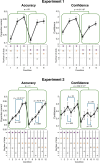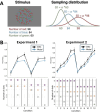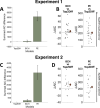This is a preprint.
A novel behavioral paradigm reveals the nature of confidence computation in multi-alternative perceptual decision making
- PMID: 39711537
- PMCID: PMC11661388
- DOI: 10.21203/rs.3.rs-5510856/v1
A novel behavioral paradigm reveals the nature of confidence computation in multi-alternative perceptual decision making
Abstract
A central goal of research in perceptual decision making is to determine the internal computations underlying choice and confidence in complex, multi-alternative tasks. However, revealing these computations requires knowledge of the internal representation upon which the computations operate. Unfortunately, it is unknown how traditional stimuli (e.g., Gabor patches and random dot motion) are represented internally, which calls into question the computations inferred when using such stimuli. Here we develop a new behavioral paradigm where subjects discriminate the dominant color in a cloud of differently colored dots. Critically, we show that the internal representation for these stimuli can be described with a simple, one-parameter equation and that a single free parameter can explain multi-alternative data for up to 12 different conditions. Further, we use this paradigm to test three popular theories: that confidence reflects (1) the probability of being correct, (2) only choice-congruent (i.e., positive) evidence, or (3) the evidence difference between the highest and the second-highest signal.The predictions of the first two theories were falsified in two experiments involving either six or 12 conditions with three choices each. We found that the data were best explained by a model where confidence is based on the difference of the two alternatives with the largest evidence. These results establish a new paradigm in which a single parameter can be used to determine the internal representation for an unlimited number of multi-alternative conditions and challenge two prominent theories of confidence computation.
Keywords: Confidence; computational models; metacognition; perceptual decision making.
Conflict of interest statement
Additional Declarations: There is NO Competing Interest.
Figures






Similar articles
-
Challenging the Bayesian confidence hypothesis in perceptual decision-making.Proc Natl Acad Sci U S A. 2024 Nov 26;121(48):e2410487121. doi: 10.1073/pnas.2410487121. Epub 2024 Nov 22. Proc Natl Acad Sci U S A. 2024. PMID: 39576348 Free PMC article.
-
Suprathreshold perceptual decisions constrain models of confidence.PLoS Comput Biol. 2022 Jul 27;18(7):e1010318. doi: 10.1371/journal.pcbi.1010318. eCollection 2022 Jul. PLoS Comput Biol. 2022. PMID: 35895747 Free PMC article.
-
How do humans give confidence? A comprehensive comparison of process models of perceptual metacognition.J Exp Psychol Gen. 2024 Mar;153(3):656-688. doi: 10.1037/xge0001524. Epub 2023 Dec 14. J Exp Psychol Gen. 2024. PMID: 38095983 Free PMC article.
-
Evidence or Confidence: What Is Really Monitored during a Decision?Psychon Bull Rev. 2023 Aug;30(4):1360-1379. doi: 10.3758/s13423-023-02255-9. Epub 2023 Mar 14. Psychon Bull Rev. 2023. PMID: 36917370 Free PMC article. Review.
-
A computational framework for the study of confidence in humans and animals.Philos Trans R Soc Lond B Biol Sci. 2012 May 19;367(1594):1322-37. doi: 10.1098/rstb.2012.0037. Philos Trans R Soc Lond B Biol Sci. 2012. PMID: 22492750 Free PMC article. Review.
References
-
- Acerbi L., & Ma W. J. (2017). Practical Bayesian Optimization for Model Fitting with Bayesian Adaptive Direct Search. Advances in Neural Information Processing Systems, 1836–1846.
Publication types
Grants and funding
LinkOut - more resources
Full Text Sources

